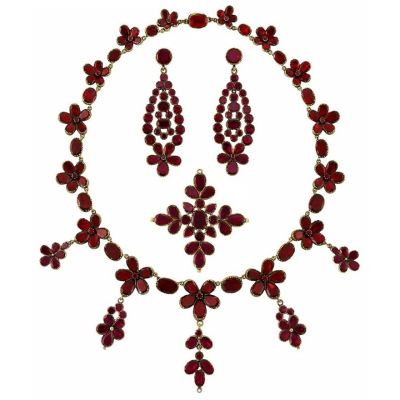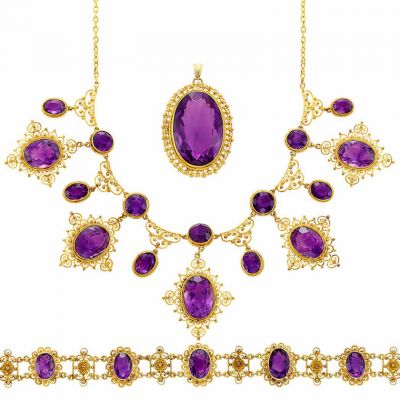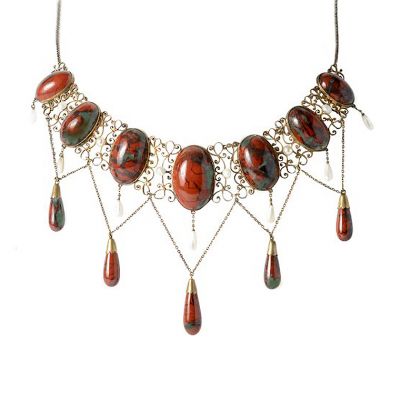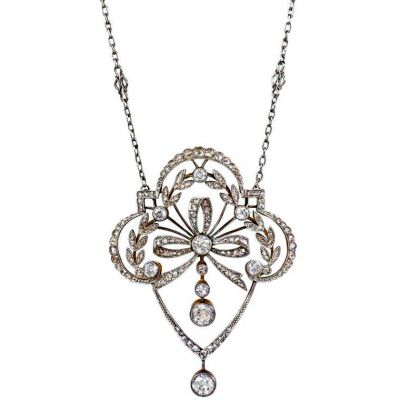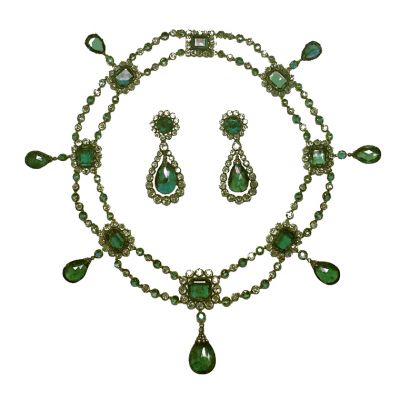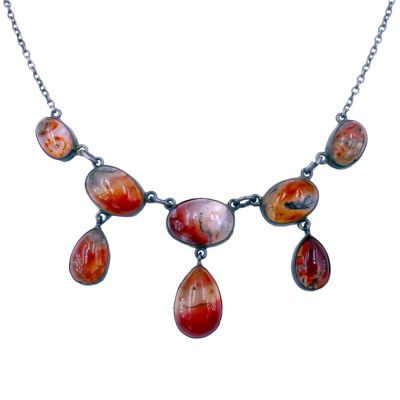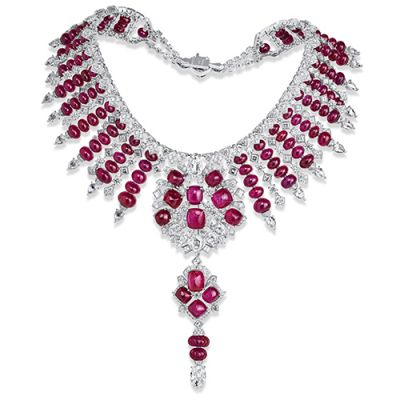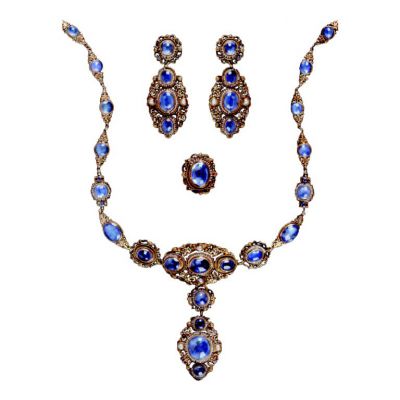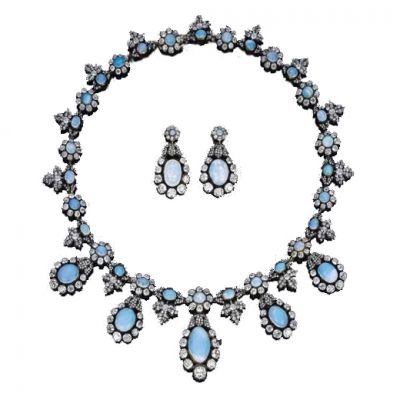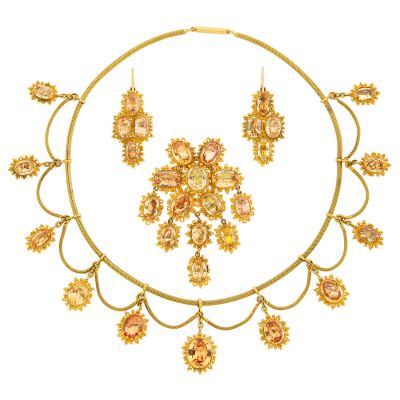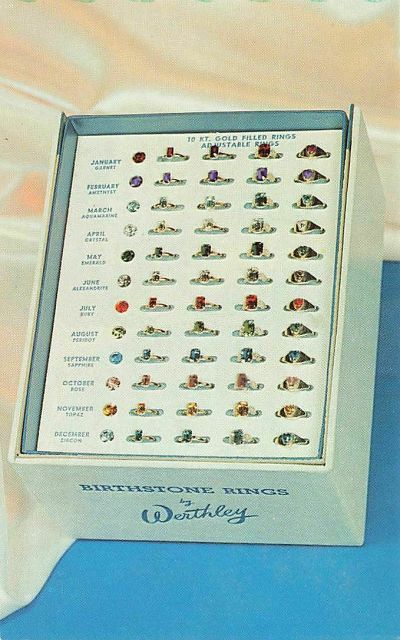The Tiffany Birthstone Poem: Difference between revisions
(img and caption) |
(edit and save) |
||
| Line 149: | Line 149: | ||
'' To bring her joy and peace of mind.''</blockquote> | '' To bring her joy and peace of mind.''</blockquote> | ||
== The | == The Poem Meets The High-End-Jewelers == | ||
The Tiffany Birthstone poem was, as noted, composed in a way to make it sound old-fashioned or even antique, even when it was new. The twelve stones that were selected comprised a heterodox assortment. | |||
Some were rare, precious, translucent gemstones. They were generally facet-cut and colour-matched, and only the wealthy could afford them. | |||
* Diamond | |||
* Emerald | |||
* Ruby | |||
* Sapphire | |||
* Topaz | |||
Some were common, semi-precious, translucent gem-stones. They were generally facet-cut and colour-matched, Bu the upper-middle-class could afford them. | |||
* Amethyst | |||
* Garnet | |||
Some were common, opaque or semi-opaque figured stones. They were commonly cut as cabochons or used for cameo or intaglio engraving | |||
* Agate | |||
* Bloodstone | |||
* Opal | |||
* Sardonyx | |||
* Turquoise | |||
In this latter group, the agate, bloodstone, and sardonyx were old fashioned, heavy and mostly opaque subjects. Agate was, and is, a dime-a-dozen rock, and bloodstone is nothing more than a very fancy form of jasper -- and as beautiful as individually figured pieces may be, they are casual stones, not easily colour-matched. Sardonyx had a run of several decades of popularity in the carving of cameos, but when Italian carvers flooded the market with shell cameos during the late 19th and early 20th century, the more expensive sardonyx cameos fell out of favour. Turquoise, always a bit exotic and rare, albeit unreliable in its colour stability, hit new highs of popularity when its use in Navajo silver-smithing was placed before the American public during the 19920s, and has remained consistently popular due to its historical connection to the American Southwest. | |||
In making the shift from the old to the new, from the common to the precious, jewelers tinkered with the list of stones, and thus with the poem. | |||
* Over the years June's humble Agate fell out of favour with jewelers, to be replaced with the more costly "Pearls" -- which, alas, breaks the scansion, unless one is in the habit of pronouncing "Pearls" as "Per'-uls." | |||
* Some jewelers took themselves even farther, naming June's stone as Alexandrite, which does not fit the meter of the verse at all. | |||
* Likewise, the old-fashioned "Sardonyx" of August was, by some jewelers, replaced with "Peridot," which, although it has the correct number of syllables, places the stress on a different syl-LAB-le. | |||
== The Dime Store Birthstone Ring == | |||
Years after the introduction of artisnal and amuletic birthstone jewelry, which was considered a thoughtful or even devotional gift with strong magical resonances, the birthstone ring became a cheap and simple present to give a young girl about whom you knew very little except the month she was born.. | |||
[[File:Birthstone-Rings-By-Werthley-front-2-Dexter-Press-Chrome.jpg|center|thumb|400px|A 1950s chrome-era postcard advertising the Werthly line of dime store gemstone rings]] | |||
[[File:Birthstone-Rings-By-Werthley-back-2-Dexter-Press-Chrome.jpg|center|thumb|400px|1950s Werthly Birthstone Rings advertising postcard, back. ]] | [[File:Birthstone-Rings-By-Werthley-back-2-Dexter-Press-Chrome.jpg|center|thumb|400px|1950s Werthly Birthstone Rings advertising postcard, back. ]] | ||
| Line 168: | Line 196: | ||
On the back of the 1950s Werthly advertising postcard we see that the chipboard counter-top box is self-stocking, with drawers of replacement rings at the ready to fill the empty places as these 10k gold-filled trinkets are sold. | On the back of the 1950s Werthly advertising postcard we see that the chipboard counter-top box is self-stocking, with drawers of replacement rings at the ready to fill the empty places as these 10k gold-filled trinkets are sold. | ||
==To Discuss This Patreon Page== | ==To Discuss This Patreon Page== | ||
This Patreon Bonus Page is part of the series titled "Your Wate and Fate." To discuss it with me and the Patron community, please visit our | This Patreon Bonus Page is part of the series titled "Your Wate and Fate." To discuss it with me and the Patron community, please visit our Private Patreon Forum at | ||
'''http://forum.luckymojo.com/your-wate-and-fate-t93995.html''' | '''http://forum.luckymojo.com/your-wate-and-fate-t93995.html''' | ||
Thank you. | Thank you. | ||
Revision as of 02:36, 21 February 2021
The Tiffany Birthstone Poem, also known as The Gregorian Birthstone Poem is an anonymous series of 12 short verses, each four lines long, that attribute one birthstone to each month of the year. It was printed in a pamphlet by Tiffany and Co., a fine jewelry store, in 1870, presumably to encourage the sales of birthstone jewelry. The word "Gregorian" in the title is not explained; it seems to allude to an older era of Gregorian monks and pre-Raphaelite aesthetics, matching the poetical form, which is deliberately antiquated. In keeping with its supposed antiquity, it had no attribution, and seems not to have been copyrighted.
Birthstone postcards with verses that derive from his poem:
Thanks to my Patron Kristina Bailey for bringing The Tiffany Birthstone Poem to my attention.
JANUARY
"By her who in this month was born
No gem save Garnets shall be worn
They will ensure her constancy,
True friendship, and fidelity.
FEBRUARY
"The February born shall find
Sincerity and peace of mind,
Freedom from passion and from care,
If they the amethyst will wear."
MARCH
"Who in this world of ours their eyes
In March first open shall be wise,
In days of peril firm and brave
And wear a Bloodstone to the grave."
APRIL
"She who from April dates her years
Diamonds should wear, lest bitter tears
For vain repentance flow; this stone,
Emblem of innocence is known."
MAY
"Who first beholds the light of day
In Spring's sweet flowery month of May
And wears an Emerald all her life
Shall be a loved and a loving wife."
JUNE
"Who comes with summer to this earth,
And owes to June her hour of birth,
With ring of Agate on her hand
Can health, wealth, and long life command."
JULY
"The glowing Ruby shall adorn
All those who in July are born,
For thus they'll be exempt and free,
From love’s doubts and anxiety."
AUGUST
"Wear Sardonyx or for thee,
No conjugal felicity;
The August-born without this stone,
`Tis said, must live unloved and lone."
SEPTEMBER
"A maiden born when autumn leaves
Are rustling in September's breeze,
A Sapphire on her brow should bind;
'Twill cure diseases of the mind."
OCTOBER
"October's child is born for woe,
And life's vicissitudes must know,
But lay an Opal on her breast,
And hope will lull those woes to rest."
NOVEMBER
"Who first comes to this world below
With drear November's fog and snow,
Should prize the Topaz amber hue,
Emblem of friends and lovers true."
DECEMBER
"If cold December gave you birth
The month of snow and ice and mirth
Place on your hand a Turquoise blue;
Success will bless whate'er you do."
The Poem Meets the Folk Process
The verses of this poem follow the familiar sing-song pattern i call "the English Enchantment." Dating back at least to the Renaissance and the writing of William Shakespeare, such verses are found to this day in the metrical magical spells of the Anglo-Saxon people. The same scansion, with a variety of wordings, is found on many fortune telling tea cups, as seen at our sister-site, The Mystic Tea Room in the page about Poetry on Cups and Saucers.
Thirty-five years after its first publication, when the chromolithographic postcard craze took off in 1905, the Tiffany Birthstone Poem was considered to be in the public domain, and thus it formed the basis for many of the Birthstone postcard texts, even those that do not contain the full four lines per card, but make do instead with a mere rhymed couplet.
In the hands of a variety of English and American postcard publishers, the text was meddled by quite other anonymous authors, either in an attempt to modernize it or to change the stones attributed to the months.
- The old-fashioned "drear November" became, to some, "dreary November," breaking the meter.
- The rather ominous advice that the September-born maiden,
A Sapphire on her brow should bind;
'Twill cure diseases of the mind
became the comfortably cheerful
A Sapphire on her brow should bind;
To bring her joy and peace of mind.
The Poem Meets The High-End-Jewelers
The Tiffany Birthstone poem was, as noted, composed in a way to make it sound old-fashioned or even antique, even when it was new. The twelve stones that were selected comprised a heterodox assortment.
Some were rare, precious, translucent gemstones. They were generally facet-cut and colour-matched, and only the wealthy could afford them.
- Diamond
- Emerald
- Ruby
- Sapphire
- Topaz
Some were common, semi-precious, translucent gem-stones. They were generally facet-cut and colour-matched, Bu the upper-middle-class could afford them.
- Amethyst
- Garnet
Some were common, opaque or semi-opaque figured stones. They were commonly cut as cabochons or used for cameo or intaglio engraving
- Agate
- Bloodstone
- Opal
- Sardonyx
- Turquoise
In this latter group, the agate, bloodstone, and sardonyx were old fashioned, heavy and mostly opaque subjects. Agate was, and is, a dime-a-dozen rock, and bloodstone is nothing more than a very fancy form of jasper -- and as beautiful as individually figured pieces may be, they are casual stones, not easily colour-matched. Sardonyx had a run of several decades of popularity in the carving of cameos, but when Italian carvers flooded the market with shell cameos during the late 19th and early 20th century, the more expensive sardonyx cameos fell out of favour. Turquoise, always a bit exotic and rare, albeit unreliable in its colour stability, hit new highs of popularity when its use in Navajo silver-smithing was placed before the American public during the 19920s, and has remained consistently popular due to its historical connection to the American Southwest.
In making the shift from the old to the new, from the common to the precious, jewelers tinkered with the list of stones, and thus with the poem.
- Over the years June's humble Agate fell out of favour with jewelers, to be replaced with the more costly "Pearls" -- which, alas, breaks the scansion, unless one is in the habit of pronouncing "Pearls" as "Per'-uls."
- Some jewelers took themselves even farther, naming June's stone as Alexandrite, which does not fit the meter of the verse at all.
- Likewise, the old-fashioned "Sardonyx" of August was, by some jewelers, replaced with "Peridot," which, although it has the correct number of syllables, places the stress on a different syl-LAB-le.
The Dime Store Birthstone Ring
Years after the introduction of artisnal and amuletic birthstone jewelry, which was considered a thoughtful or even devotional gift with strong magical resonances, the birthstone ring became a cheap and simple present to give a young girl about whom you knew very little except the month she was born..
On the back of the 1950s Werthly advertising postcard we see that the chipboard counter-top box is self-stocking, with drawers of replacement rings at the ready to fill the empty places as these 10k gold-filled trinkets are sold.
To Discuss This Patreon Page
This Patreon Bonus Page is part of the series titled "Your Wate and Fate." To discuss it with me and the Patron community, please visit our Private Patreon Forum at
http://forum.luckymojo.com/your-wate-and-fate-t93995.html
Thank you.
